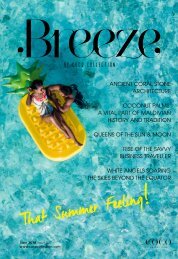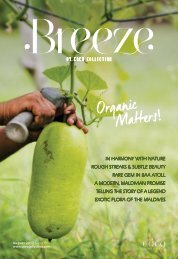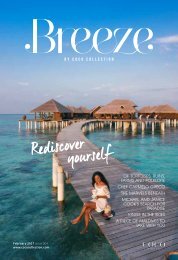Create successful ePaper yourself
Turn your PDF publications into a flip-book with our unique Google optimized e-Paper software.
DESIGN & INSPIRATION<br />
Arrival of modernity and tourism<br />
Due to the increasing exposure to modernity and the<br />
arrival of tourism, it was during the early 80s that these<br />
boats with their own special Maldivian features began<br />
to evolve.<br />
Maldives opened its borders to tourists in the<br />
late 70s and along with the opening of the first few<br />
tourist resorts, the nation’s liveaboard industry also<br />
began to stir into life. The first of the liveaboards<br />
were traditional dhonis with their lateen sails, slightly<br />
modified so that tourists can sleep, eat, and live on the<br />
vessel. But soon, they started becoming mechanised.<br />
And this trend also began to be mirrored by the fishing<br />
vessels. For the fishermen, the addition of the motors<br />
did increase their fuel costs. However, due to better<br />
mobility and speed, the fishermen saw their catches<br />
double. By the mid-90s, most of the fishing vessels<br />
registered in the country were mechanised.<br />
According to Philippe Laurella, a long time boat<br />
builder and a veteran of the Maldivian liveaboard<br />
industry, “The evolution of boat construction lead to<br />
the standardisation of the design, especially for the<br />
safari boats, and today, they look like something similar<br />
to a mega yacht but in a smaller size.” Phillipe built one<br />
of the first liveaboard vessels of the country. He named<br />
it Baraabaru, and according to him it was inspired by<br />
the design of the Maldivian sea vessel bahtheli.<br />
Once the mechanisation of the wooden boats went<br />
into full swing, Maldivian boat builders also came<br />
across the need to look into other building materials.<br />
“When the construction was done by only using wood,<br />
it looked nice, but the problem was maintenance. Year<br />
after year, the (maintenance) cost becomes higher and<br />
the time that the boats spend stocked on the dry dock<br />
becomes longer,” explains Phillipe.<br />
Fiberglass<br />
Maldivian boat builders chose the solution of building<br />
them using fibreglass; a material that would provide<br />
waterproof boats without any infiltration of water.<br />
According to Wajeeh, “The most important factor to<br />
consider when selecting boat building materials is the<br />
weight strength ratio, and fibreglass is an ideal material<br />
because its weight strength ratio is very low, meaning<br />
strong structures can be made by using it thinly.”<br />
However, Wajeeh notes that while fibreglass has its<br />
beneficial characteristics, it is also very hazardous to<br />
the environment.<br />
Apart from fibreglass, Maldivian boat builders are<br />
also now using imported wood and other such suitable<br />
materials.<br />
Still Evolving<br />
No longer constrained by the height of the coconut<br />
trees, Maldives now produces boats that are even as<br />
long as 100 feet. Most of them equipped with diesel<br />
engines, today’s vessels come with convenience<br />
and speed. They are often equipped with the latest<br />
technology and feature the latest trends in passenger<br />
comfort and navigational safety.<br />
The shapes, the construction techniques, and<br />
the materials have evolved so far from the humble<br />
sailing dhoni made from coconut palm wood. And<br />
the traditional art of building a boat without using a<br />
drawing is also becoming something that’s known and<br />
practiced by only a handful of craftsmen.<br />
www.cococollection.com<br />
37














